Journal of Biomaterials and Nanobiotechnology, 2019, 10, 120-141
http://www.scirp.org/journal/jbnb
ISSN Online: 2158-7043
ISSN Print: 2158-7027
Nanobiotechnology in Agricultural Sector:
Overview and Novel Applications
Katherine Alvarado1, Mónica Bolaños1, Carmen Camacho1, Elías Quesada1, José Vega-Baudrit1,2
1Chemistry Department, National University of Costa Rica, Heredia, Costa Rica
2National Nanotechnology Laboratory LANOTEC-CeNAT-CONARE, San José, Costa Rica
How to cite this paper: Alvarado, K.,
Bolaños, M., Camacho, C., Quesada, E. and
Vega-Baudrit, J. (2019) Nanobiotechnology
in Agricultural Sector: Overview and Novel
Applications. Journal of Biomaterials and
Nanobiotechnology, 10, 120-141.
https://doi.org/10.4236/jbnb.2019.102007
Received: November 27, 2018
Accepted: April 23, 2019
Published: April 26, 2019
Copyright © 2019 by author(s) and
Scientific Research Publishing Inc.
This work is licensed under the Creative
Commons Attribution International
License (CC BY 4.0).
http://creativecommons.org/licenses/by/4.0/
Open Access
Abstract
The agricultural sector has many problems achieving the desired yield in
products because of pathogens, viruses, pesticides, herbicides, temperature,
soil moisture, among others. Nanotechnology, along with other sciences, has
emerged in industry and society due to the interest in solving problems such
as those mentioned above, in order to serve the needs of the world popula-
tion. The present review discusses the principal topics about Nanobiotech-
nology, such as generalities, applications, aspects that can be improved and
perspectives, beside its influence in the agriculture industry.
Keywords
Component, Nanotechnology, Biotechnology, Agriculture,
Nanobiotechnology
1. Introduction
Nanotechnology is present in almost all areas of our daily life and is recognized
by the European Commission as one of the six “Key Enabling Technologies” that
contribute to sustainable competitiveness and growth in many areas of industrial
application [1]. There are a variety of concepts about nanotechnology in the li-
terature, however, it can be defined as a novel, innovative and interdisciplinary
science field that involves the designing, development and application of mate-
rials and devices at molecular level in nanometric scale [2]. In other words, it is a
field of applied science and technology which deals/involves in manipulating
matter and its atoms and molecules with the purpose of fabricating materials,
devices and systems with new characteristics that can improve their applications
[3]. The principle of Nanotechnology is to work atom by atom, with the purpose
of obtaining structures with new molecular organization and through this, to
120
Journal of Biomaterials and Nanobiotechnology
DOI: 10.4236/jbnb.2019.102007 Apr. 26, 2019
�
K. Alvarado et al.
exploit these properties and develop innovative devices [4].
On the other hand, biotechnology uses the techniques of biology in order to
manipulate molecular, genetic and cellular processes to develop products and
services and it can be used in diverse fields from medicine to food and agricul-
ture [5].
Having said that, the Nanobiotechnology is the integration of nanotechnolo-
gy, biotechnology and also chemical and physical processing, material science
and system engineering with the aim of obtaining new products previously
modified at nanoscale that may have improved conditions with respect to the
conventional materials [6].
Due to the new chemical, physical and biological properties of nanomaterials
and nanoparticles, they have been rapidly exploited in many areas such as agri-
culture, food, medicine, pharmacy, electronics, material science and energy sec-
tors among others [2] [6].
For many countries, agriculture sector is very important for their economy,
including more than 60% of the population which depends upon agriculture to
earn their livelihood directly or indirectly [1].
Agriculture is one of the most important and stable sector because it produces
and provides raw materials, mainly for food and feed industries. The limit of
natural resources (production land, water, soil), the growth of the population in
the world, the increasing global food security and the climate change, claim the
agricultural development to be economically further, viable, environmentally
and efficiently [2] [5]. For the agriculture, the change in properties is thanks to
the possibility to manipulate, change and reduce the atomic and molecular size,
what allows to change the interactions between molecules and hence, have mate-
rials with new characteristics. The new properties and possibilities of nanotech-
nology in this area are high reactivity, sensitivity, enhanced bioavailability and
bioactivity, adherence effects and different surface effects [7].
Now, after years of green revolution and decline in the agricultural products
ratio to world population growth, it is obvious the necessity of employing new
technologies in the agriculture industry. Modern technologies such as bio and
nanotechnologies can play an important role in increasing the annual produc-
tion and improving the quality of food produced by farmers. Many believe that
modern technologies will secure growing world food needs as well as deliver a
huge range of environmental, health and economic advantages [3].
The need of new science and technology interventions have allowed to revolu-
tionize the agricultural industry with novel tools for the molecular management
of diseases, rapid disease detection, enhancing the ability of plants to absorb nu-
trients, improving agricultural productivity and efficiency with lower cost and
less waste, among others [4] [8].
To conclude, the objective of this investigation is to elaborate a review about
nanotechnology in the agriculture sector, learn about its generalities, important
applications and aspects that can be improved.
121
Journal of Biomaterials and Nanobiotechnology
DOI: 10.4236/jbnb.2019.102007
�
K. Alvarado et al.
DOI: 10.4236/jbnb.2019.102007
History
The concept of “Nanoscience” has been attributed to Laureate Richard Feynman
in 1959 and the term “Nanotechnology” was used for the first time in 1974 by
Norio Taniguchi of the Tokyo Science University [7]. After that, the develop-
ment of nanotechnologies has been attributed to two inventions that have revo-
lutionized imaging and manipulation of nanoscale objects: The Scanning
Tunneling Microscope (STM) invented in 1981 and the Atomic Force Micro-
scope (AFM) in 1986. These instruments practically opened the door for scien-
tists to the “nanoworld” and since these discoveries the studies in nanotechnol-
ogy don’t cease to increase in the innovations in electronics and also in the use
of nanoparticles in many areas [9].
On the other hand, the studies about nanotechnology in agriculture started
growing for industrial applications nearly half a century ago, nevertheless, the
impulse to other scientists for its use is attributed to recently reports published,
which are focused on identifying the research areas that should be found and al-
so on set the agenda for nanotechnology research in agricultural applications,
which became the principal guiding force for many nations that have agriculture
as primary occupation of the population [10].
2. Applications in Agriculture
Nowadays, the world’s population is growing very rapidly, and it is expected to
reach 8.5 billion by 2030 [11], which means that the demand for food, natural
resources like water, land to establish cities and cultivate, will also increase [12].
In the same matter, the climate change due to the pollution has caused a very
negative impact on the crop production [12]. In that sense, the food industry
needs to come up with quick and novel alternatives in order to fulfill the heavy
demand for food and the shortage of land and water.
Currently, some of the solutions to cope with those problems have been the
use of fertilizers, pesticides and genetically modified organisms (GMO) [13].
Nevertheless, the indiscriminate use of chemical compounds to increase the crop
production or efficiency, has caused serious issues like heavy soil, air and water
contamination, human and animal diseases and destabilization of the ecosys-
tems [12] [14]. For example, related to the overuse of pesticides, many of the
pests that affect the crops have developed resistance, analogous to the bacterial
antibiotic resistance, which causes that the farmers tend to use more quantity
and stronger pesticides, some of them being quite toxic [15].
With that being said, bio and nanotechnology now comes into play, as inno-
vative technologies that may have the solutions to many of the issues that the
humans and agricultural industry have been facing [1] [6] [13]. As an illustra-
tion, Table 1 shows some of the main materials used in agriculture that have
been developed using nanometric technologies [15] [16] [17].
2.1. Nanofertilizers
Like mentioned above, fertilizers are chemical substances, like urea, ammonium
122
Journal of Biomaterials and Nanobiotechnology
�
Table 1. Nano materials used nowadays in agriculture [15] [16] [17].
Material
Purpose
K. Alvarado et al.
Magnetic carbon coated nanoparticles
Polyhydroxybutyte-co-hydroxyvalerate
microspheres with atrazine
(about 13 nm)
Inorganic Zn-Al layered double
hyroxide (ZAL) as release agent
Controlled released herbicide and Smart
agrochemical delivery system used in several
plants such as tomato, sunflower and pea
Nano controlled release system of
2-4-dichlorophenoxyacetate used as herbicides
Porous hollow silica nanoparticles
Nano controlled release system
of wáter soluble pesticide
CNT conjugated with INF24
oligonucleotides
Silver nanoparticles (AgNPs)
Reduce rust disease and control pathogens
Amphotericin B nanodisks
Treatment of fungal pathogens (proved in vitro)
Gold nanoparticles (AuNPs)
Delivery of DNA during transformation of plant cells
Plant growth promoting rhizobacteria
salts, phosphates, among others, used to increase the crop production, as they
facilitate the access to nutrients required for growing [13] [15]. However, in or-
der to achieve the enormous required amount of food, farmers have resorted to
the use of conventional fertilizers at high rates and long periods of time, which is
the main anthropogenic factor that has caused the eutrophication of coastal and
freshwater ecosystems [18].
In that way, different approaches have been developed to deal with this issue.
One of them is the creation of nanofertilizers, that are either nanomaterials that
can supply nutrients to the plant, or those that act as enhancers of the traditional
fertilizers, but do not directly provide the nutrients [18]. For example, nanopar-
ticles made out of hydroxyapatite, TiO2, SiO2, or even carbon nanotubes [13].
In regards of the uptake mechanism by the plants, there are two main me-
chanisms [18]. The first consists on the nanoparticle entering directly into the
plant cells through pores on the cell wall, in this case, the size of the nanoparticle
needs to be smaller than the pore size (5 to 20 nm) [18]. The seconds involves
the dissolution of the nanoparticles, which are absorbed through the roots of the
plant and release the nutrients as soluble ions [18]. Also, the advantage of using
nanoparticles is that the dissolution of these in water or soil is higher compared
to the conventional fertilizers, because of its smaller particle size and higher spe-
cific surface area [18].
Another strategy has been the development of biofertilizers, in which are used
beneficial microorganisms that are able to convert organic matter into com-
pounds that are nutritional for the plant and, at the same time, maintain the soil
fertility and its natural habitat [15]. Nevertheless, this approach has a few draw-
backs, like short shelf life, lack of suitable carrier materials, high temperature
and desiccation sensitivity [15]. Therefore, in order to overcome those issues,
123
Journal of Biomaterials and Nanobiotechnology
DOI: 10.4236/jbnb.2019.102007
�
K. Alvarado et al.
DOI: 10.4236/jbnb.2019.102007
polymeric nanoparticles for coating to resist desiccation, might be a great appli-
cation [15]. For example, scientists have investigated the interaction between
gold nanoparticles (GNPs) and plant growth promoting rhizobacteria (PGPR)
[17]. The results showed a significant increase on growth for some of the strains
tested, like P. fluorescens, P. elgii and B. subtilis, hence, GNPs have great poten-
tial as nano-biofertilizers [17].
2.2. Nanopesticides
Some materials contain elements in the nanometer size that claims novel prop-
erties associated with these small size, in this way, nanopesticides are defined as
any formulation that includes this type of modified materials to generate more
efficient products. Since materials vary their properties depending on their size,
there is a wide range of nanopesticides that cannot be considered as a single cat-
egory. For example, some of them are made of organic ingredients like polymers
and, in the other hand, some nanopesticides may have inorganic ingredients like
metal oxides. It should be noted that the nanomaterials were introduced into
pesticides in various forms (particles and micelles); and this nanometric mate-
rials are introduced into pesticides to release the active ingredient more slowly
and in a selectively way to increase the solubility of the poorly soluble active in-
gredient o thereby protect the ingredient against premature degradation [19].
In these days, resist environmental conditions such as sun, heat, rain, to be
transported through the target and penetrate efficiently the organism (fungus,
insect, etc) or to resist defense of the pest/pathogen, are some of the more im-
portant characteristics of an ideal pesticide. Even so, pesticides do not have such
good chemical characteristics, that is why, now nanomaterials are implemented
in this products. Likewise, it has been observed that in economic terms, intro-
ducing nanoparticules into pesticides provide monetary, social and environ-
mental benefits by formulating more controlled modes of action. To achieve
this, nanomaterials have potential for developing safer chemical pesticide for-
mulations for applications in the field.
Another point to take into account is that nanotechnology has been incorpo-
rated into pesticides through the use of nanosuspensions, nanoparticles and po-
lymeric nanoparticles. Nowadays, these forms of introduction into the nanopes-
ticides have been tested to observe their efficiency and effectiveness [15].
Among the main nanomaterials used to improve the properties of pesticides
are found the iron oxide nanoparticles and gold nanoparticles, they are mostly
used because their easily way to be synthesized. According to the size, the phar-
macokinetic parameters can be altered shape and functionalization of the surface
of the nanomaterials [20]. That is why, nanotechnology can take an important
part in the development of sustainable agriculture, since this technology can
control the delivery of nutrients and monitoring the water quality used in this
field [5]. As a consequence, it is important to encourage the use and spread of
nanomaterials in this aspect.
124
Journal of Biomaterials and Nanobiotechnology
�
K. Alvarado et al.
Nanopores open up opportunities for agriculture by the improvement of new
productivity using research in nanotechnology. For example, Zeolites are nano-
capsules of water, herbicides or fertilizers used for efficient dosing and slow re-
lease of the vector for pest management. The manipulation of nanoparticles
makes possible the arrangement of atoms, modifying shapes, sizes and functions.
This allows the manufacture of advanced objects such as Zeolites for the con-
trolled release of active agents such as pesticides [21].
Reducing waste and labor costs are some of the benefits that nanotechnology
promises by streamlining agricultural management. Therefore, nanopesticides
increased average crop yield by 20%, sunflower by 50%; rice by 35% and cu-
cumber by 25%. Nowadays, some researches shows that nano-iron oxide pesti-
cides increased rice yields by 25% and soybean yields increased 48% [22].
2.2.1. Management of Insect Pest
Nanoscale science and engineering have an important role in the creation of
agricultural system for the generation of safer food under more controlled pro-
duction. Although commercial advances and technological impacts are limited
due to the relative novelty of the use of nanotechnology in agriculture and food
systems, some encouraging results have been obtained. From the perspective of
food safety, nanotechnology has a lot to offer, such as the control of insect pests
[23].
Insects are one of the most known animal species around the world. They are
found in all types of environment. Insects fed on all kinds of plants including
crop plants, forest trees, medicinal plants and weeds. They also infest the food
and other stored products in warehouses, bins, storage structures and packages
causing huge amount of loss to the stored food and also deterioration of food
quality [6].
The effectiveness of metal nanoparticles against plants pathogens, insects and
pests were proven in previous studies. Hence, nanoparticles can be used in the
preparation of new formulations like pesticides, insecticides and insect repellants
[6] [15].
2.2.2. Antifungal Properties of Nanomaterials
The efficiency of nanoparticles on the control of the growth of some bacteria and
fungi on plants has been proven. New Silver nanoparticles (SNPs) have been
studied as pesticides for fungal and bacterial control; this is because by having
such a small size they are able to penetrate the wall and cell membrane in large
scale in biological processes. The antibacterial activity of silver ions has been well
established. These SNPs have fungistatic, bacteriostatic and plasmonic properties
that are eco-friendly inhibitors against plant-pathogens compared with synthetic
fungicides [24]. SNPs can attack membranes and structures denaturing cell. This
nanomaterial disrupts transport systems, such as ion efflux, causing a rapid ac-
cumulation of silver ions, interrupting cellular processes such as respiration and
metabolism by reacting with the molecules [24] [25].
125
Journal of Biomaterials and Nanobiotechnology
DOI: 10.4236/jbnb.2019.102007
�
K. Alvarado et al.
DOI: 10.4236/jbnb.2019.102007
In the same way, in terms of nanotechnology, studies have been published on
copper nanoparticles and copper oxide nanoparticles for the phytopathological
and phytosanitary application [26]. Another nanoparticle used to control fungal
pathogens is the chitosan, a natural compound that has several applications in
biology, because of its capacity of being biodegradable, safe and non-toxic, envi-
ronmentally friendly and low-cost production. Some investigations found that
chitosan has antifungal properties because the interaction between amino groups
of chitosan and negative charges of the macromolecules at the outside of the
fungal cell wall [27].
2.3. Nanosensors
Agricultural production continues to be constrained by biotic and abiotic fac-
tors. For instance, insect pests, diseases and weeds cause considerable damage to
agricultural production [6]. Regarding this, Nanotechnology has allowed the use
of nanosensors, which are sophisticated instruments that can respond to physi-
cal, chemical or biological aspects and transfer that response into a signal that
can be used by humans, allowing to detect many factors due to drought, temper-
ature, insect or pathogen pressure, or lack of nutrients [5]. Many years ago the
people used traditional techniques such as gas or liquid chromatography and
mass spectroscopy instead of nanosensors, however, these devices have the ad-
vantages of being small, portable, sensitive with real-time monitoring, precise,
quantitative, reliable, accurate, reproducible, robust and stable. Because of that,
an alternative to analytical methods could not only improve the efficiency in the in-
vestigations but also reduce the cost associated with the traditional methods; the
unique and different characteristics of nanomaterials, such as size/shape-dependent
optical property, easy and fast turning in surface properties and catalytic func-
tions are very useful for the signal generation and signal amplification [28] [29].
Moreover, the possibility of on-site monitoring allow farmers to closely monitor
environmental conditions for plant growth and crop protection and also can
contribute to increase the productivity and decreased the use of agrochemicals
such as antibiotics, pesticides and nutrients by early intervention; besides that,
people can utilize inputs more efficiently by indicating the nutrient or water sta-
tus of crop plants over fine spatial and temporal scales and through this, apply
nutrients, water, or crop protection (insecticide, fungicide or herbicide) only
where and when necessary [5] [15].
These smart sensors in the agriculture sector are considered a powerful tool
for track detect and control animal and plant pathogen, mainly because the de-
vices help in the detection of chemical contaminants, virus and bacteria in agri-
cultural systems, nutrient content and plant stress [20].
Some specific applications of these sensors in agriculture are the MEMS (Mi-
cro Electro Mechanical Systems) that through microelectronic circuits are capa-
ble of sensing and monitoring temperature and moisture in soil, to diagnose oil
disease (caused by infecting soil microorganisms, such as viruses, bacteria and
126
Journal of Biomaterials and Nanobiotechnology
�
K. Alvarado et al.
fungi) via the quantitative measurement of differential oxygen consumption in
the respiration of good microbes and bad microbes in the soil. Also biosensors
are developed, using photosystem II, known to bind several groups of herbicides
and chemicals, among others [7].
Through the development of new devices, farmers and population will be be-
nefited in aspects such as economic gain, reduced environmental pollution and
lower labor costs [30].
2.4. Nanobiosensors
Physical and chemical new properties of nanoscale materials are also exploitable
in the development of biosensors. Nanomaterials are used in biosensors with the
purpose of improve their sensitivity and efficiency through new signal transduc-
tion technologies [5]. Nanosensors with immobilized bioreceptor which is selec-
tive for target analyte molecules are called nanobiosensors. In other words, this
is a modified version of a biosensor that incorporates a biological derived sensi-
tized element linked to a physical-chemical transducer. This device integrates a
biological element with an electronic component to yield a measurable signal
and in the other hand, the biological recognition is through the transducer
process [5] [31].
The conventional nanobiosensors have three principal components (Figure
1). The probe or biologically sensitized elements such as enzymes, antibodies,
DOI: 10.4236/jbnb.2019.102007
Figure 1. Principle of a nanobiosensor [31].
127
Journal of Biomaterials and Nanobiotechnology
�
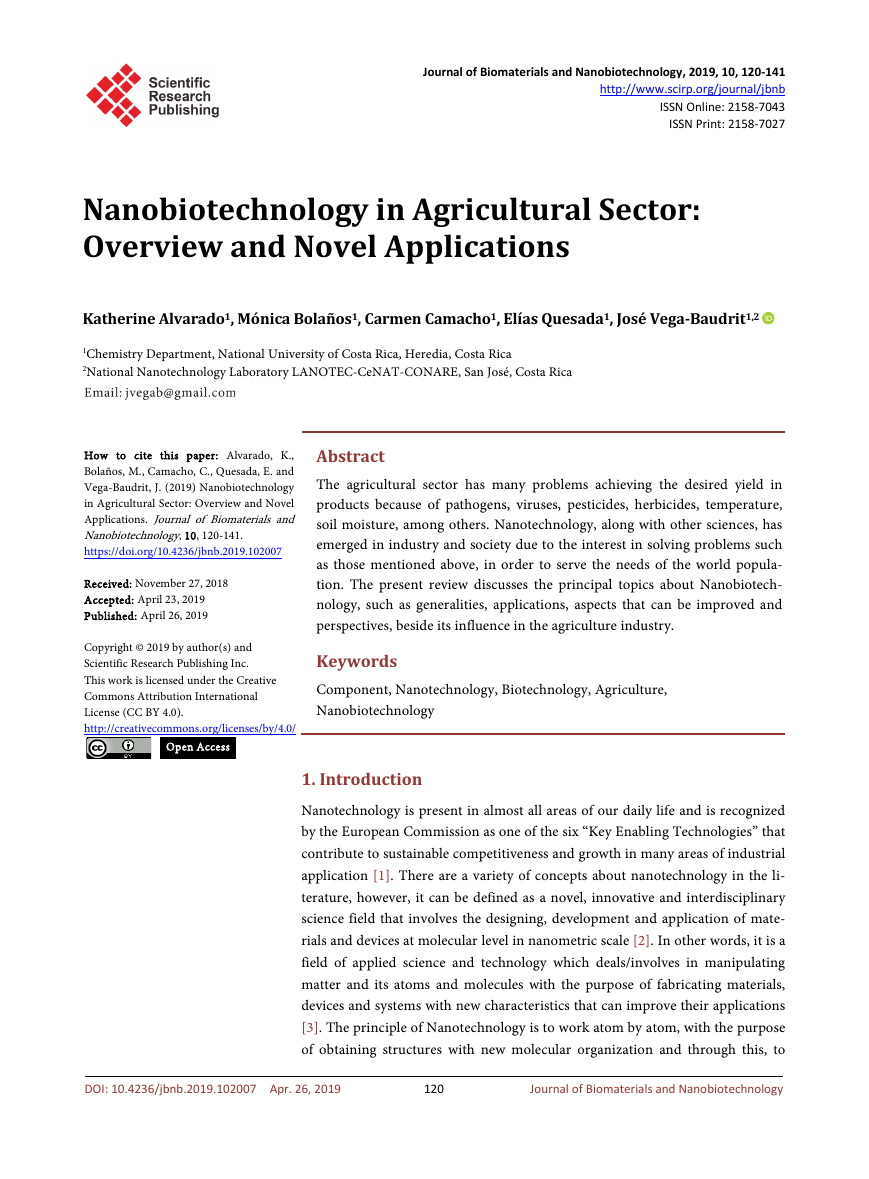

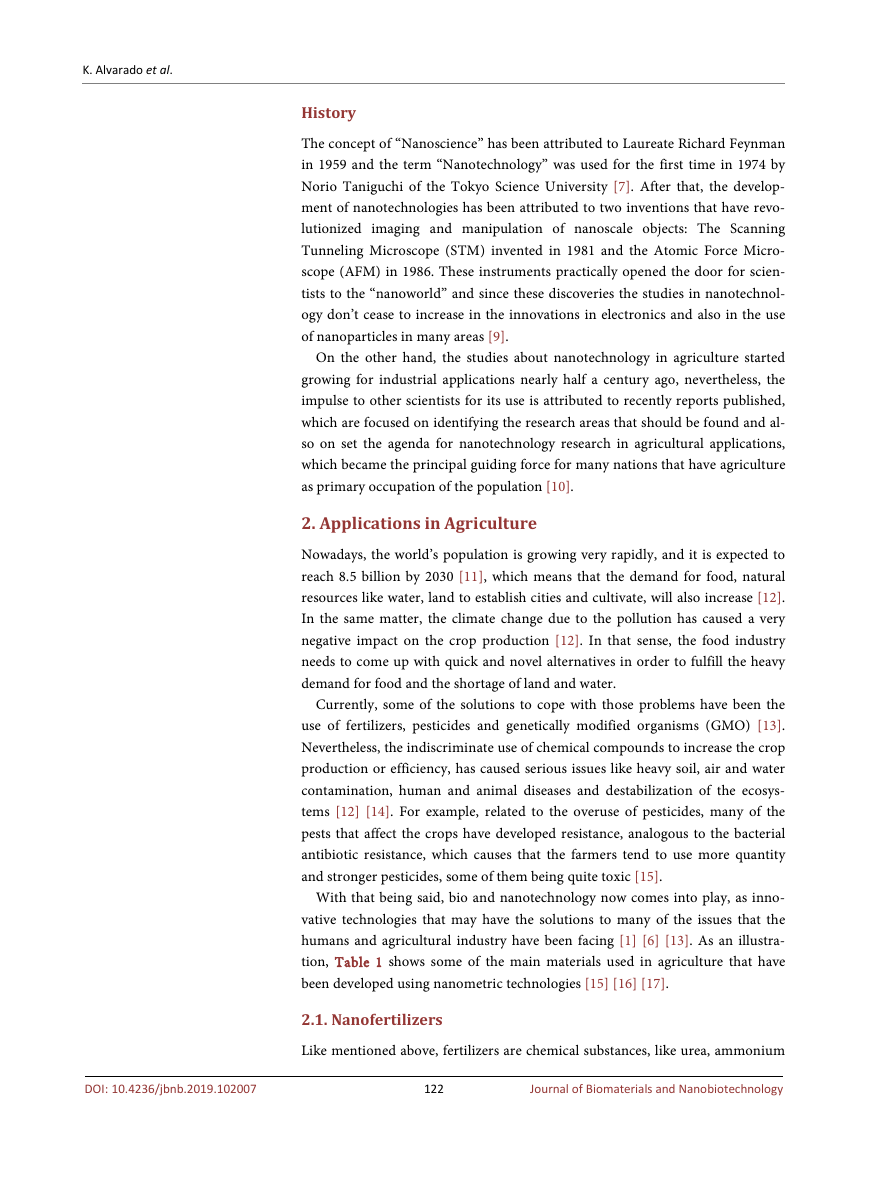
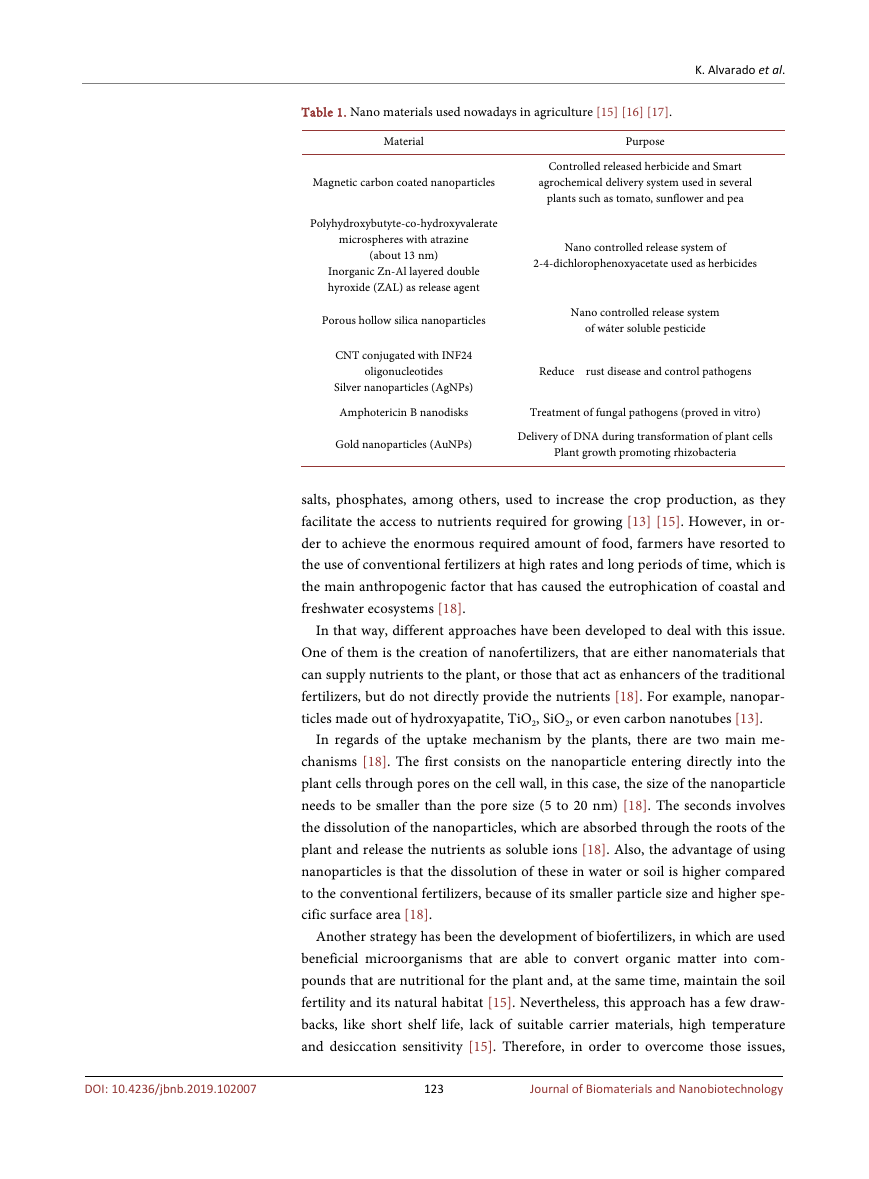
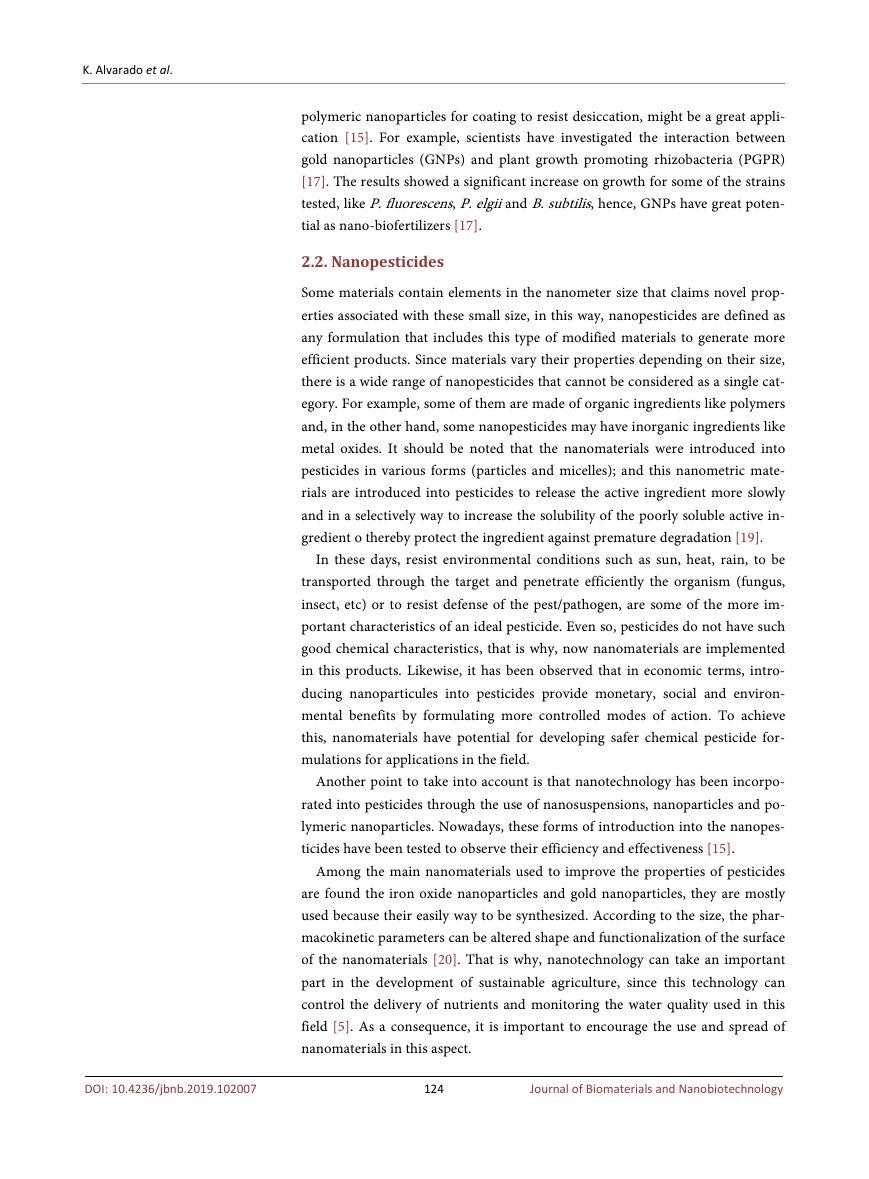
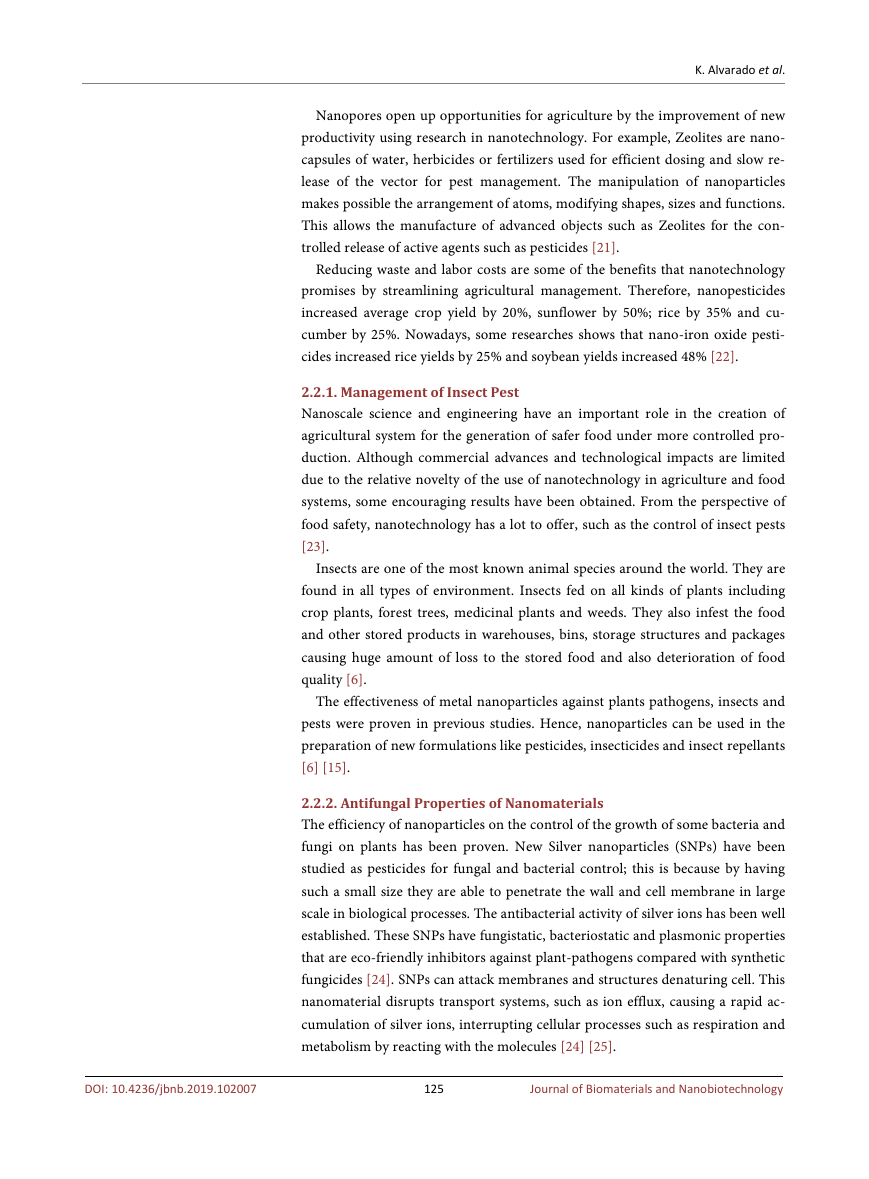










 2023年江西萍乡中考道德与法治真题及答案.doc
2023年江西萍乡中考道德与法治真题及答案.doc 2012年重庆南川中考生物真题及答案.doc
2012年重庆南川中考生物真题及答案.doc 2013年江西师范大学地理学综合及文艺理论基础考研真题.doc
2013年江西师范大学地理学综合及文艺理论基础考研真题.doc 2020年四川甘孜小升初语文真题及答案I卷.doc
2020年四川甘孜小升初语文真题及答案I卷.doc 2020年注册岩土工程师专业基础考试真题及答案.doc
2020年注册岩土工程师专业基础考试真题及答案.doc 2023-2024学年福建省厦门市九年级上学期数学月考试题及答案.doc
2023-2024学年福建省厦门市九年级上学期数学月考试题及答案.doc 2021-2022学年辽宁省沈阳市大东区九年级上学期语文期末试题及答案.doc
2021-2022学年辽宁省沈阳市大东区九年级上学期语文期末试题及答案.doc 2022-2023学年北京东城区初三第一学期物理期末试卷及答案.doc
2022-2023学年北京东城区初三第一学期物理期末试卷及答案.doc 2018上半年江西教师资格初中地理学科知识与教学能力真题及答案.doc
2018上半年江西教师资格初中地理学科知识与教学能力真题及答案.doc 2012年河北国家公务员申论考试真题及答案-省级.doc
2012年河北国家公务员申论考试真题及答案-省级.doc 2020-2021学年江苏省扬州市江都区邵樊片九年级上学期数学第一次质量检测试题及答案.doc
2020-2021学年江苏省扬州市江都区邵樊片九年级上学期数学第一次质量检测试题及答案.doc 2022下半年黑龙江教师资格证中学综合素质真题及答案.doc
2022下半年黑龙江教师资格证中学综合素质真题及答案.doc